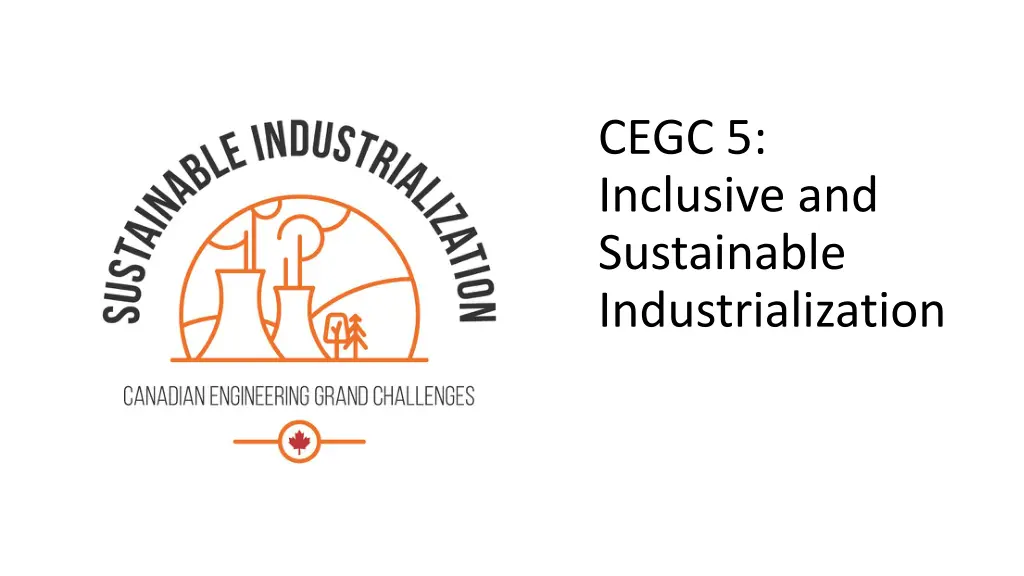
Canadian Engineering Grand Challenge for Sustainable Industrialization
Discover the Canadian Engineering Grand Challenge focusing on sustainable industrialization, reconciling environmental protection with manufacturing needs. Learn about the importance of inclusive and sustainable industrial development, aligned with United Nations Sustainable Development Goals.
Download Presentation

Please find below an Image/Link to download the presentation.
The content on the website is provided AS IS for your information and personal use only. It may not be sold, licensed, or shared on other websites without obtaining consent from the author. If you encounter any issues during the download, it is possible that the publisher has removed the file from their server.
You are allowed to download the files provided on this website for personal or commercial use, subject to the condition that they are used lawfully. All files are the property of their respective owners.
The content on the website is provided AS IS for your information and personal use only. It may not be sold, licensed, or shared on other websites without obtaining consent from the author.
E N D
Presentation Transcript
CEGC 5: Inclusive and Sustainable Industrialization
Connection to the United Nations Connection to the United Nations Sustainable Development Goals Sustainable Development Goals
What is the Canadian Engineering Grand What is the Canadian Engineering Grand Challenge Statement? Challenge Statement? The challenge for sustainable industrialization is to reconcile the tension between industrialization and the manufacturing of products with the need to safeguard our environment and our natural resources (EDC-DDIC, 2022).
High Level Overview of the Canadian High Level Overview of the Canadian Engineering Grand Challenge Engineering Grand Challenge Manufacturing and heavy industries are vitally important to the world economy. The existence of large-scale manufacturing allows for many of the conveniences that people take for granted in the modern world. Looking closer to home, manufacturing is one of the single largest contributors to the Canadian GDP. In 2021, it accounted for roughly two thirds of all Canada s merchandise exports. Industry provides valuable jobs to Canadians across the country. The value of industrialization is apparent; however, much waste is produced in the process and profits are not always equitable.
High Level Overview of the Canadian High Level Overview of the Canadian Engineering Grand Challenge Engineering Grand Challenge Sustainable industrialization is the push towards industry that is not only economically successful in the long-term, but also minimizes the energy and natural resources consumed. To achieve this, the push towards a circular economy must be sustained, with the goal of zero waste or greenhouse gas emissions. Inclusive industrialization is defined by the United Nations as industrial development that offers equal opportunities and an equitable distribution of the benefits of industrialization to all stakeholders. In order to achieve the goal of both inclusive and sustainable industrialization, the engineers of today must be prepared to creatively and intelligently approach these challenges.
Example Connection to a Sustainable Example Connection to a Sustainable Development Goal Development Goal CEGC 5: Inclusive and Sustainable Industrialization maps to several Sustainable Development Goals, where an example of one of the connections is to SDG 12 - Responsible Consumption and Production, which has a goal to Ensure sustainable consumption and production patterns (United Nations, 2023).
Keywords: industrialization, circular economy, equitable distribution, eco-design, life cycle analysis, extended producer responsibility
Status of the Challenge Globally Status of the Challenge Globally While strides have been made to reduce emissions from industrial activities in some countries, there are still many countries throughout the world that emit harmful levels of greenhouse gas emissions. Waste from manufactured products has formed two large collections of marine debris known as the Great Pacific Garbage Patch which are still growing. Natural resources continue to be consumed at an unsustainable rate.
Status of the Challenge in Canada Status of the Challenge in Canada Economics and Inclusivity Manufacturing is one of the single largest contributors to the Canadian GDP. It currently accounts for 68% of all Canada s merchandise exports and provides over 1.7 million jobs to Canadians across the country (Canadian Manufacturing Sector Gateway, 2021). The value of industrialization is apparent; however, the profits are not always equitable. Economic growth does not mean success if it amplifies inequalities. Canada currently has industrial policy and is investing public dollars, it is merely a question of whether the policy will be implemented effectively (An inclusive industrial policy for Canada, 2021).
Status of the Challenge in Canada Status of the Challenge in Canada Sustainability Industry is clearly very important to Canada; however, it comes with its own set of drawbacks for the environment. In 2020, heavy industry accounted for 10.6% of total Canadian greenhouse gas emissions. Progress has been made in recent years to reduce the emissions from industry, and 2020 was the lowest year for industry emissions in Canada since 2009 (Greenhouse Gas Emissions, 2022). Canada is also pushing towards creating a circular economy. A circular economy is one that converts waste from one application into inputs for another process. The global economy was estimated to be 6% circular in 2005 (Willi Haas, Fridolin Krausmann, Dominik Wiedenhofer, and Markus Heinz, n.d.). The current lack of a circular economy is producing industrial waste at an unsustainable rate.
Roadblocks to Success Roadblocks to Success Inclusive and sustainable industrialization is achievable, but there are several challenges that have barred this achievement from already being completed. From the perspective of the producer, environmental benefits do not often line up with what would be financially optimal. Lack of legislation and regulations on end-of-life responsibilities allow producers to take environmental shortcuts. Legislation also currently fails to provide incentive programs that guide sustainable economic development. Even if a producer wanted to be completely environmentally friendly, it can often be difficult. One issue is that many products are complex in both the number of materials used and in how they are integrated. This can make it challenging for products to be recycled or reused efficiently. Recycling also takes energy, meaning it still has an environmental impact. Additionally, recycling often degrades material quality. From a consumer standpoint, not everyone cares enough to recycle their used goods, and lack of understanding about recycling can lead those who do care to improperly recycle.
Strategies to Meet 2030 Targets Strategies to Meet 2030 Targets To address the challenge of practising inclusive and sustainable industrialization, Engineering Deans Canada have identified the following strategies (EDC-DDIC, 2022): Contributing to the circular economy where waste products become input to produce other value-added products. Improving research and teaching on eco-design as well as ways to predict or forecast when an outcome that occurs is going to be later recognized as a large problem. Suppressing waste in all stages of industrialization and production. Recycling and reusing products we make. Designing for sustainability, recyclability and biodegradability of all the products we produce.
Strategies to Meet 2030 Targets Strategies to Meet 2030 Targets To address the challenge of practising inclusive and sustainable industrialization, Engineering Deans Canada have identified the following strategies (EDC-DDIC, 2022): Including both energy and water use in life cycle analyses carried out for products. Digitizing and collecting product use data in our daily lives and industrial practices that can be used for life cycle analysis. Improving efficiency of resource use. Adding extended producer responsibility for products which are manufactured and used. Adding more legislation and regulatory frameworks to realize the implementation of all these priorities.
References References EDC-DDIC. (2022, May 6). Canadian Engineering Grand Challenges (2020-2030). Engineering Deans Canada. Retrieved February 23, 2023, from https://engineeringdeans.ca/en/canadian-engineering-grand-challenges-2020- 2030-inspiring-action-to-improve-life-for-canadians-and-the-world/ United Nations (2023). The 17 Goals, United Nations Department of Economic and Social Affairs, Sustainable Development. Retrieved February 27, 2023, from https://sdgs.un.org/goals Willi Haas, Fridolin Krausmann, Dominik Wiedenhofer, and Markus Heinz. (n.d.) How Circular is the Global Economy? An Assessment of Material Flows, Waste Production, and Recycling in the European Union and the World in 2005, Journal of Industrial Ecology, Vol 19, No. 5, 2015, 765-777. https://onlinelibrary.wiley.com/doi/full/10.1111/jiec.12244






















